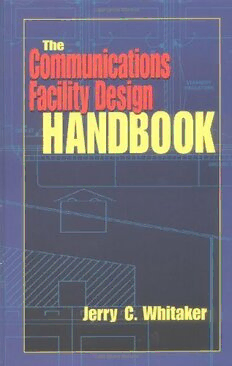
The Communications Facility Design Handbook PDF
Preview The Communications Facility Design Handbook
The CCoommmmuunniiccaattiioonnss FFaacciilliittyy DDeessiiggnn HANDBOOK Jerry C. Whitaker ELECTRONICS HANDBOOK SERIES Series Editor: Jerry C. Whitaker Technical Press Morgan Hill, California P U B L I S H E D T I T L E S AC POWER SYSTEMS HANDBOOK, SECOND EDITION Jerry C. Whitaker THE ELECTRONIC PACKAGING HANDBOOK Glenn R. Blackwell POWER VACUUM TUBES HANDBOOK, SECOND EDITION Jerry C. Whitaker F O R T H C O M I N G T I T L E S ELECTRONIC SYSTEMS MAINTENANCE HANDBOOK Jerry C. Whitaker FORMULAS FOR THERMAL DESIGN OF ELECTRONIC EQUIPMENT Ralph Remsberg THE RESOURCE HANDBOOK OF ELECTRONICS Jerry C. Whitaker The CCoommmmuunniiccaattiioonnss FFaacciilliittyy DDeessiiggnn HANDBOOK Jerry C. Whitaker CRC Press Boca Raton London New York Washington, D.C. Library of Congress Cataloging-in-Publication Data Catalog information is available from the Library of Congress. This book contains information obtained from authentic and highly regarded sources. Reprinted material is quoted with permission, and sources are indicated. A wide variety of references are listed. Reasonable efforts have been made to publish reliable data and informa- tion, but the author and the publisher cannot assume responsibility for the validity of all mate- rials or for the consequences of their use. Neither this book nor any part may be reproduced or transmitted in any form or by any means, electronic or mechanical, including photocopying, microfilming, and recording, or by any information storage or retrieval system, without prior permission in writing from the pub- lisher. The consent of CRC Press LLC does not extend to copying for general distribution, for pro- motion, for creating new works, or for resale. Specific permission must be obtained in writing from CRC Press LLC for such copying. Direct all inquiries to CRC Press LLC, 2000 N.W. Corporate Blvd., Boca Raton, Florida 33431. Trademark Notice: Product or corporate names may be trademarks or registered trademarks, and are used only for identification and explanation, without intent to infringe. © 2000 by CRC Press LLC No claim to original U.S. Government works International Standard Book Number 0-8493-0908-5 Printed in the United States of America 1 2 3 4 5 6 7 8 9 0 Printed on acid-free paper Preface Fromtheearliestdaysofelectronics,theconceptsofsystemdesignhaveevolvedand engineering practices have been developed. Signal parameters, connector and cable specifications, and equipment-mounting dimensions have all been standardized. Most of the equipment and hardware used to assemble systems today are available fromanumberofmanufacturers;end-usersdonothavetocustom-buildtheircompo- nents. These advances have helped to significantly reduce the engineering design time required for a given project. Many systems of advanced design with superior performanceandimprovedoperatingefficiencyhaveresulted.Veteranengineersand technicalmanagersarefamiliarwiththesepracticesandstandards.However,thisis notnecessarilythecaseforlessexperiencedengineersornewengineerswhoarejust entering the electronics industry. Thishandbookhasbeenwrittentoestablishafoundationfordesigning,installing, operating,andmaintainingaudio,video,computer,andradiofrequencysystemsand facilities.Itdescribestheimportantstepsrequiredtotakeaprojectfrombasicdesignto installation and completion. Thishandbookexaminesthetasksandfunctionsforwhichthesystemengineerwill generallyberesponsible.Itdiscussesstepsrequiredtocompletecomplexprojects.For smallerprojects,thesestepscanbeimplementedeasilyand—insomecases—certain stepsanddocumentationcanbesimplifiedoreliminatedwithoutcompromisingthe success of the project. Althoughsmallprojectscanbecompletedbyasingleengineer,largerprojectsre- quirethesystemengineertoworkwithmanyotherpeople.Thereaderwillrealizethat thestructureofdifferentorganizationswithincompaniesvariesgreatly,asdothere- sponsibilities of the individuals who make up the organization. Withinanycompany,thefunctionoftheengineerwillvary.Athoroughunderstand- ingofelectronicsfundamentalsandtheworkingsofaprojectorganizationcanhelpen- gineersunderstandtheirresponsibilitiesanddealwiththemanyissuesinvolvedinfa- cilitydesign.Manyorganizationshaveengineeringdepartmentsthathaveestablished standardsforbuildingsystemsforinternaluseor,inthecaseofsystemintegratorswho buildturnkeysystemsfortheirclients,forinstallationattheclient’sfacility.Eitherway, this handbook will serve as a valuable reference. Thesystemengineerisresponsibleforspecifyingallofthedetailsofhowafacility willbebuilt,anditisthatperson’sresponsibilitytocommunicatethosedetailstothe contractors,craftsmen,andtechnicianswhowillactuallybuildandinstallthehardware andsoftware.Thesystemengineerisfurtherresponsibleforinstallationqualityandul- timate performance. Successfulexecutionoftheseresponsibilitiesrequiresanunderstandingoftheun- derlyingtechnologiesandtheapplicablequalitystandardsandmethodsforachieving them.The Communications Facility Design Handbookis dedicated to that effort. For updated information on this and other engineering books, visit the author’s Internet site www.technicalpress.com About the Author JerryWhitakerisatechnicalwriterbasedinMorganHill,California,whereheoper- atestheconsultingfirmTechnicalPress.Mr.Whitakerhasbeeninvolvedinvarious aspectsofthecommunicationsindustryformorethan25years.HeisaFellowofthe Society of Broadcast Engineers and an SBE-certified Professional Broadcast Engi- neer.HeisalsoamemberandFellowoftheSocietyofMotionPictureandTelevision Engineers,andamemberoftheInstituteofElectricalandElectronicsEngineers.Mr. Whitakerhaswrittenandlecturedextensivelyonthetopicofelectronicsystemsin- stallation and maintenance. Mr.WhitakeristheformereditorialdirectorandassociatepublisherofBroadcast EngineeringandVideoSystemsmagazines.Heisalsoaformerradiostationchiefengi- neer and TV news producer. Mr. Whitaker is the author of a number of books, including: (cid:127) Power Vacuum Tubes Handbook, 2nd edition, CRC Press 1999. (cid:127) AC Power Systems, 2nd edition, CRC Press, 1998. (cid:127) DTV: The Revolution in Electronic Imaging, 2nd edition, McGraw-Hill, 1999. (cid:127) Editor-in-Chief,NABEngineeringHandbook,9thedition,NationalAssociation of Broadcasters, 1999. (cid:127) Editor-in-Chief,The Electronics Handbook, CRC Press, 1996. (cid:127) Coauthor, Communications Receivers: Principles and Design, 2nd edition, McGraw-Hill, 1996. (cid:127) Electronic Displays: Technology, Design, and Applications, McGraw-Hill, 1994. (cid:127) Coeditor,StandardHandbookofVideoandTelevisionEngineering,3rdedition, McGraw-Hill, 2000. (cid:127) Coeditor,Information Age Dictionary, Intertec/Bellcore, 1992. (cid:127) Maintaining Electronic Systems, CRC Press, 1991. (cid:127) RadioFrequencyTransmissionSystems:DesignandOperation,McGraw-Hill, 1990. (cid:127) Coauthor, Television and Audio Handbook for Technicians and Engineers, McGraw-Hill, 1990. Mr.WhitakerhastwicereceivedaJesseH.NealAwardCertificateofMeritfromthe AssociationofBusinessPublishersforeditorialexcellence.Healsohasbeenrecog- nized asEducator of the Yearby the Society of Broadcast Engineers. Acknowledgment Theauthorwishestoexpressappreciationtothefollowingcontributorsfortheirassis- tance in the preparation of this book. K. Blair Benson E. Stanley Busby Michael W. Dahlgren Gene DeSantis C. Robert Paulson Richard Rudman Contents Chapter 1: Electronics Fundamentals Introduction Electrical Fundamentals Conductors and Insulators Direct Current (dc) Alternating Current (ac) Electronic Circuits Circuit Analysis AC Circuits Power Relationship in AC Circuits Complex Numbers Phasors Per Unit System Static Electricity Magnetism Electromagnetism Magnetic Shielding Electromagnetic-Radiation Spectrum Low-End Spectrum Frequencies (1 to 1000 Hz) Low-End Radio Frequencies (1000 to 100 kHz) Medium-Frequency Radio (20 kHz to 2 MHz) High-Frequency Radio (2 to 30 MHz) Very High and Ultrahigh Frequencies (30 MHz to 3 GHz) Microwaves (3 to 300 GHz) Infrared, Visible, and Ultraviolet Light X-Rays Passive Circuit Components Resistors Wire-Wound Resistor Metal Film Resistor Carbon Film Resistor Carbon Composition Resistor Control and Limiting Resistors Resistor Networks Adjustable Resistors Attenuators Capacitors Polarized Capacitors Nonpolarized Capacitors Film Capacitors Foil Capacitors Electrolytic Capacitors Ceramic Capacitors Polarized-Capacitor Construction Aluminum Electrolytic Capacitors Tantalum Electrolytic Capacitors Inductors and Transformers Losses in Inductors and Transformers Air-Core Inductors Ferromagnetic Cores Shielding Diodes and Rectifiers The pn Junction Zener Diodes and Reverse Breakdown Current Regulators Varistor Indicators Active Circuit Components Vacuum Tubes Bipolar Transistors NPN and PNP Transistors Transistor Impedance and Gain Transistor Configurations Switching and Inductive-Load Ratings Noise Field-Effect Transistors FET Impedance and Gain Integrated Circuits Digital Integrated Circuits Linear Integrated Circuits References Bibliography Chapter 2: Modulation Systems Introduction Principles of Resonance Series Resonant Circuits Parallel Resonant Circuits Cavity Resonators Operating Class Amplitude Modulation Frequency Modulation Modulation Index Phase Modulation Pulse Modulation Digital Modulation Systems Pulse Amplitude Modulation Pulse Time Modulation Pulse Code Modulation Delta Modulation Digital Coding Systems Baseband Digital Pulse Modulation Spread Spectrum
